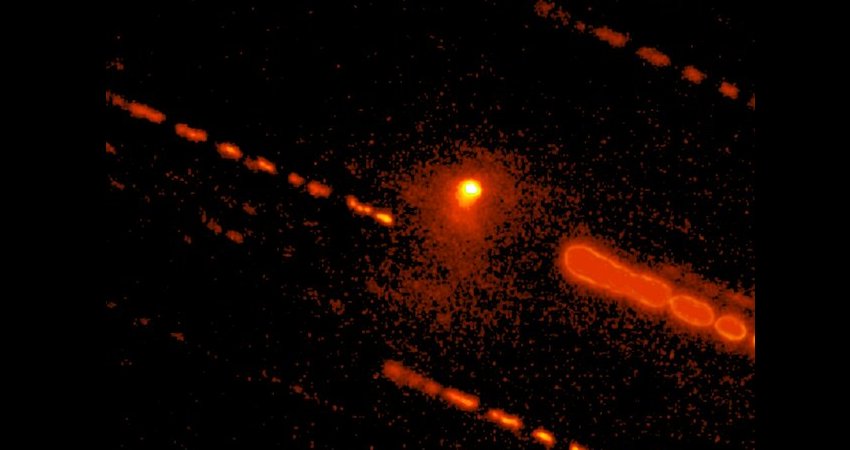Shallow Lakes In Icy Crust Of Jupiter’s Moon Europa Could Erupt – New Study
Eddie Gonzales Jr. – MessageToEagle.com – In the search for life beyond Earth, subsurface bodies of water in our outer solar system are some of the most important targets. That’s why NASA is sending the Europa Clipper spacecraft to Jupiter’s moon Europa: There is strong evidence that under a thick crust of ice, the moon harbors a global ocean that could potentially be habitable.
This illustration depicts a plume of water vapor that could potentially be emitted from the icy surface of Jupiter’s moon Europa. New research sheds light on what plumes, if they do exist, could reveal about lakes that may be inside the moon’s crust. Credit: NASA/ESA/K. Retherford/SWRI
But scientists believe the ocean isn’t the only water on Europa. Based on observations from NASA’s Galileo orbiter, they believe salty liquid reservoirs may reside inside the moon’s icy shell—some of them close to the surface of the ice and some many miles below.
The more scientists understand about the water that Europa may be holding, the more likely they will know where to look for it when NASA sends Europa Clipper in 2024 to conduct a detailed investigation. The spacecraft will orbit Jupiter and use its suite of sophisticated instruments to gather science data as it flies by the moon about 50 times.
Now, research is helping scientists better understand what the subsurface lakes in Europa may look like and how they behave. A key finding in a paper published recently in The Planetary Science Journal supports the longstanding idea that water could potentially erupt above the surface of Europa either as plumes of vapor or as cryovolcanic activity (think: flowing, slushy ice rather than molten lava).
The computer modeling in the paper goes further, showing that if there are eruptions on Europa, they likely come from shallow, wide lakes embedded in the ice and not from the global ocean far below.
“We demonstrated that plumes or cryolava flows could mean there are shallow liquid reservoirs below, which Europa Clipper would be able to detect,” said Elodie Lesage, Europa scientist at NASA’s Jet Propulsion Laboratory in Southern California and lead author of the research. “Our results give new insights into how deep the water might be that’s driving surface activity, including plumes. And the water should be shallow enough that it can be detected by multiple Europa Clipper instruments.”
Different depths, different ice
Lesage’s computer modeling lays out a blueprint for what scientists might find inside the ice if they were to observe eruptions at the surface. According to her models, they likely would detect reservoirs relatively close to the surface, in the upper 2.5 to 5 miles (4 to 8 kilometers) of the crust, where the ice is coldest and most brittle.
That’s because the subsurface ice there doesn’t allow for expansion: As the pockets of water freeze and expand, they could break the surrounding ice and trigger eruptions, much like a can of soda in a freezer explodes. And pockets of water that do burst through would likely be wide and flat like pancakes.
Reservoirs deeper in the ice layer—with floors more than 5 miles (8 kilometers) below the crust—would push against warmer ice surrounding them as they expand. That ice is soft enough to act as a cushion, absorbing the pressure rather than bursting. Rather than acting like a can of soda, these pockets of water would behave more like a liquid-filled balloon, where the balloon simply stretches as the liquid within it freezes and expands.
Sensing firsthand
Scientists on the Europa Clipper mission can use this research when the spacecraft arrives at Europa in 2030. For example, the radar instrument—called Radar for Europa Assessment and Sounding: Ocean to Near-surface (REASON)—is one of the key instruments that will be used to look for water pockets in the ice.
“The new work shows that water bodies in the shallow subsurface could be unstable if stresses exceed the strength of the ice and could be associated with plumes rising above the surface,” said Don Blankenship, of the University of Texas Institute for Geophysics in Austin, Texas, who leads the radar instrument team. “That means REASON could be able to see water bodies in the same places that you see plumes.”
Europa Clipper will carry other instruments that will be able to test the theories of the new research. The science cameras will be able to make high-resolution color and stereoscopic images of Europa; the thermal emission imager will use an infrared camera to map Europa’s temperatures and find clues about geologic activity—including cryovolcanism. If plumes are erupting, they could be observable by the ultraviolet spectrograph, the instrument that analyzes ultraviolet light.
Written by Eddie Gonzales Jr. – MessageToEagle.com Staff











